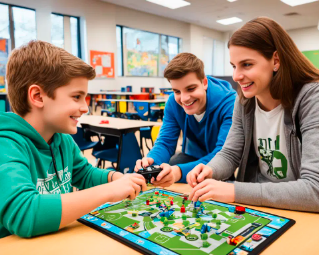In recent years, online learning has become an essential part of education, with millions of students accessing courses, tutorials, and resources from the comfort of their homes. However, one challenge that many learners face is staying engaged throughout their studies. That’s where gamification comes into play. By integrating game-like elements into educational content, gamification can make learning more interactive, fun, and effective. Let’s explore how gamification can transform the online learning experience!
What is Gamification?
Gamification is the process of incorporating game elements—such as points, badges, leaderboards, and challenges—into non-game contexts. In online learning, gamification introduces these elements to enhance student engagement and motivation. Whether it’s earning badges for completing assignments or competing for top scores on quizzes, these game-like features help make learning more exciting and rewarding.
1. Boosting Student Engagement
One of the biggest challenges in online education is keeping students engaged. Without the face-to-face interaction found in traditional classrooms, students can easily lose interest or become distracted. Gamification addresses this by making learning feel like a fun, interactive experience. Students are more likely to stay motivated when they are competing for rewards, unlocking levels, or trying to improve their scores.
For example, quiz-based games can be used to review key concepts, while students collect points as they progress. These rewards offer instant feedback and encourage students to continue learning.
2. Encouraging Healthy Competition and Collaboration
Gamification doesn’t only benefit individual learners but also fosters a sense of community and collaboration. Leaderboards allow students to track their progress against others, encouraging friendly competition. On the other hand, team-based games can encourage students to work together to complete challenges, promoting collaboration and teamwork.
When students work together to solve problems or compete for rewards, it creates a social environment that keeps them connected to the course, even in a virtual setting.
3. Personalizing the Learning Experience
Gamification allows for greater personalization in learning. By setting up customized learning paths, students can progress through course material at their own pace, with challenges suited to their abilities. This individualized approach helps prevent frustration for learners who may struggle with traditional course structures and allows high-achieving students to move ahead faster.
For example, a student might start with an introductory lesson and then unlock progressively harder levels as they master new skills, creating a tailored learning journey that suits their needs.
4. Providing Instant Feedback and Rewards
In a traditional classroom, students might wait days or even weeks for feedback on assignments. However, gamification offers immediate feedback. When students complete a quiz or challenge, they receive instant results that show them where they excelled and where they need improvement. This instant feedback keeps learners on track and helps them quickly adjust their approach.
In addition to feedback, rewards like badges or certificates give students a tangible acknowledgment of their efforts. These rewards boost self-esteem and make learning feel like a game where every milestone is celebrated.
5. Improving Retention and Long-Term Learning
Research has shown that gamification can improve information retention. Because gamified lessons are more interactive and engaging, students are more likely to remember what they’ve learned. Additionally, the sense of accomplishment tied to rewards and levels encourages learners to revisit material and practice regularly, enhancing long-term retention.
This approach is especially beneficial for complex subjects, where repetition and reinforcement are key to mastering concepts.
6. Making Learning Fun and Enjoyable
Finally, gamification transforms the often monotonous process of studying into something fun. By infusing elements of play into education, students are more likely to enjoy the learning experience and develop a positive attitude toward their studies. When learners associate fun with learning, they are more likely to stay engaged and motivated to continue their education.
Conclusion
Gamification is a powerful tool that can enhance online learning by making it more engaging, interactive, and enjoyable. From improving student engagement to fostering collaboration and providing instant feedback, gamification creates an environment where students are motivated to learn and succeed. By incorporating game-like elements into educational platforms, educators can tap into students’ natural love of play, making learning a rewarding and fun experience. So, why not make your next learning journey a game worth playing?














